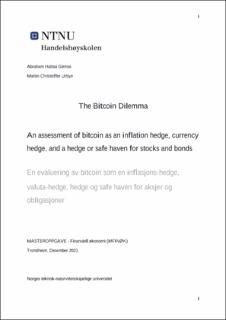The bitcoin Dilemma
Master thesis
Permanent lenke
https://hdl.handle.net/11250/2980328Utgivelsesdato
2021Metadata
Vis full innførselSamlinger
Sammendrag
Denne masteroppgaven har som mål å avklare om bitcoin fungerer som en hedge mot inflasjon, valuta, samt hedge og safe haven for aksjer og statsobligasjoner i USA, Europa, Japan, Sør-Korea og Norge. Dataen som blir tatt i bruk gjennom denne oppgaven består av US. 10-Year Breakeven Inflation Rate, tradisjonelle makroindikatorer, forskjellige vekslingskurser mot den amerikanske dollaren, aksje indekser og obligasjonsindekser for hver økonomi. Vi vurderer hver egenskap for de nevnte argumentene separat gjennom en Autoregressiv Distribuert Lag modell og deretter gjennom en Generalisert Autroregressiv Betinget Heteroskedasitet (GARCH) tilnærming. Estimeringsprosedyren utføres i to trinn, hvor vi beregner en lineær modell for første del av ligningen og bruker GARCH (1,1) til å modellere variansen i hver modell. Vår empiriske analyse viser at bitcoin er en inflasjons hedge i USA. Resultatene viser også at bitcoin oppfører seg som en risk-on/risk-off aktiva mot aksjer og statsobligasjoner under normale og usikre tider. This master thesis aims to clarify whether bitcoin acts as an inflation hedge, currency hedge, and a hedge or a safe haven for stocks and sovereign bonds in the United States, Europe, Japan, South Korea, and Norway. The data in this paper consists of the US. 10-Year Breakeven Inflation Rate, macro inflation indicators, foreign exchange rates denoted in US dollars, and stocks and sovereign bonds for each economy. We assess each property of interest separately through the Autoregressive Distributed Lag model and the Generalized Autoregressive Conditional Heteroskedasticity approach. The estimation procedure is performed in two stages, where we compute a linear model for the mean and employ the GARCH (1,1) in modeling the time-varying conditional error variance that each model residual exhibits. Our results show that bitcoin is an inflation hedge in the United States. The results also show that bitcoin behaves as a risk-on/risk-off against stocks and government bonds during normal and uncertain times.
